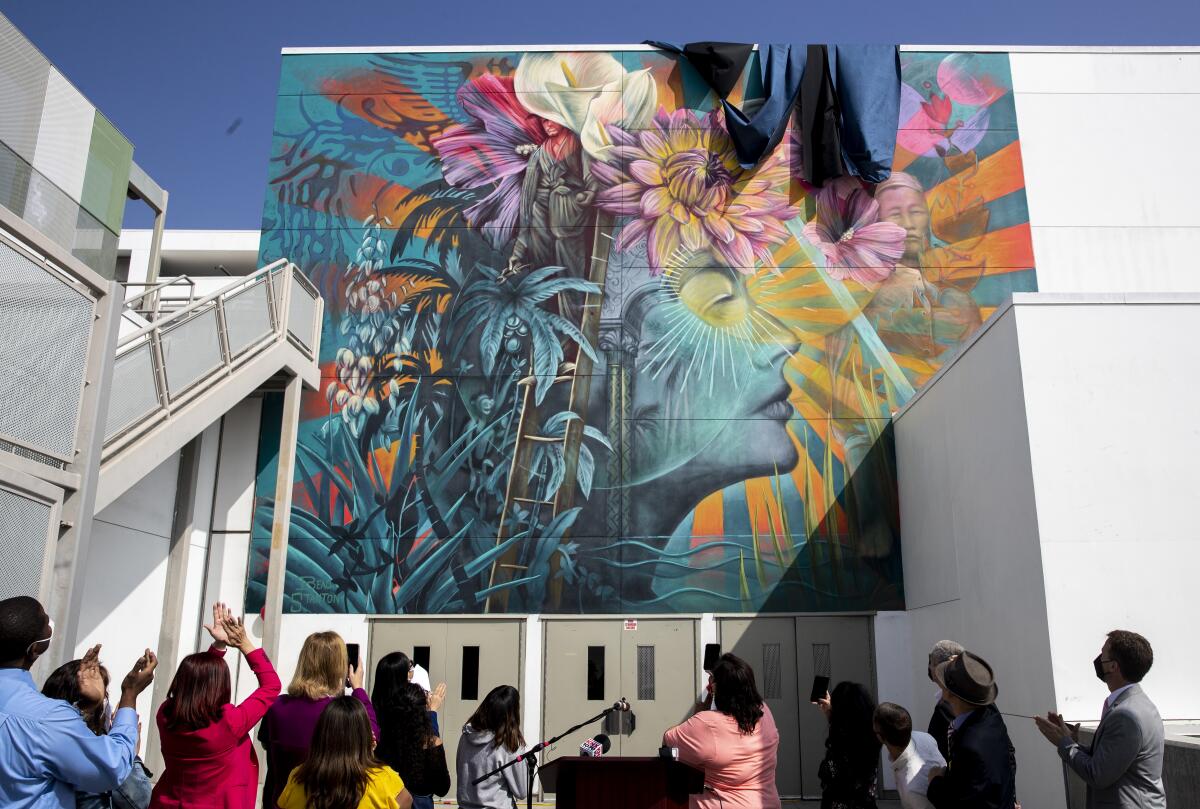School mural is transformed after original offended some Korean Americans

One early morning before students arrived, high school Principal Kate Sohn stood outside the gym and took in the reimagined version of the mural that had sparked so much controversy three years ago that it was almost destroyed.
Sohn, a Korean immigrant, focused on the hibiscus bloom, the national flower of South Korea. The principal of Ambassador School of Global Leadership, one of six schools on the Robert F. Kennedy Community Schools site, saw not only her students and the Koreatown community reflected in the many symbols in the mural â she saw herself.
âIt was very, very touching. I feel validated,â said Sohn at an unveiling of the mural Wednesday morning. âI feel like it really does represent inclusion in our community.â
The public unveiling ended a three-year ordeal that began with the intention to honor the siteâs famous past but erupted into community protests and charges of insensitivity from some in the Korean American community that surrounds the school. Others in that community found no fault with the mural.
After pandemic-related delays, the piece of public art has been changed to reflect additional elements of the rich history of the neighborhood.
As before, the mural is dominated by the likeness of actress Ava Gardner, who frequented the Ambassador Hotelâs Cocoanut Grove nightclub when it was a gathering place of the Hollywood elite. The hotel, which stood on the schoolâs site until 2005, was demolished after historic preservationists lost a battle to preserve the 85-year-old structure. The Grove was replaced with a 565-seat theater that bears the same name.
The artwork was part of a 2016 project to place murals around the campus. Two years later, the Wilshire Community Coalition, a group led by Korean Americans, spoke out against the sun rays that prominently radiated from Gardnerâs profile. Its members associated the rays with those on the rising sun of the imperial Japanese battle flag used during World War II, when Japanese forces committed atrocities against Koreans and others.
At the time, Korean groups said the symbol was as offensive as a swastika would be to Jews, or a burning cross would be to Black people. Artist Beau Stanton denied any connection between his piece and the Japanese battle flag; sun rays appear frequently in Stantonâs work, and the rays on the flag differ in number, thickness and color from the rays on the mural.
Los Angeles Unified School District officials quickly agreed to paint over the mural after coalition members threatened legal action, but the district reversed its decision amid outcry from artists.
Shepard Fairey said he would insist on the removal of his own mural on campus of Robert F. Kennedy, who was assassinated in 1968 at the Ambassador Hotel, if Stantonâs was destroyed. Some Kennedy family members also objected to the removal of Stantonâs mural.
Stanton said he could have held firm on not revising the mural on principle but instead decided to take an alternative path that would allow him to maintain artistic integrity while building on connections heâd made with community members.
The muralâs new elements are sourced from students and Koreatown community members. An initiative to collect submissions was led by GYOPO, a collective of diasporic Korean artists in Los Angeles.
âThis process and initial public conversation surrounding the original mural has been a challenging and ultimately positive experience,â Stanton wrote in an email to The Times. âI genuinely hope this saga can serve as a constructive example of how to balance the input of local stakeholders with creative free expression in public art.â
The sun rays are still incorporated into the background but are subdued in color â having gone from a bright red to a yellow-orange â and are less central to the image. Gardner is now crowned with flowers specific to the national origins of many of the students whose families emigrated from Mexico, Korea, Guatemala, El Salvador and other parts of Latin America.
The Korean pattern of a phoenix, whose tail feathers curl along the upper left side of the mural, is a symbol of rebirth and reinvention, Stanton said. A farmworker stands on a ladder in the center, harvesting oranges sourced from a historic photograph that captured one of central L.A.âs early citrus groves. A uniformed Koreatown hotel worker, based on a 1935 photograph taken at the site, is featured to the right of Gardnerâs profile.
Roberto Martinez, the senior school district administrator who helped lead the mural revision effort, thanked the Korean American community.
âThree years ago, we entered into a space of not knowing what was going to happen when we were informed about the impact that the mural had on our community, on our Korean community,â Martinez said. âYouâve taught us what the word community means, what leadership means ... We have created a space of love and respect.â
The revised artwork was acceptable to Chan Yong âJakeâ Jeong, who organized protests and had insisted that the original needed to be removed.
âI appreciate Beau, LAUSD and the community could discuss and resolve the issue with respect, care and understanding of each other with integrity,â Jeong said.
Kisuk Jun, president of the Wilshire Center Koreatown Neighborhood Council, cradled a bouquet of flowers in his arms as he stood before the mural on Wednesday. In 2018, he collected more than 1,400 signatures for a petition to paint over the mural.
Jun brought the flowers for Stanton, who was unable to attend the ceremony.
âWe came together,â he said, âAnd now itâs more beautiful â because it symbolizes Los Angeles.â
Times staff writer Howard Blume contributed to this story.
More to Read
Sign up for Essential California
The most important California stories and recommendations in your inbox every morning.
You may occasionally receive promotional content from the Los Angeles Times.











